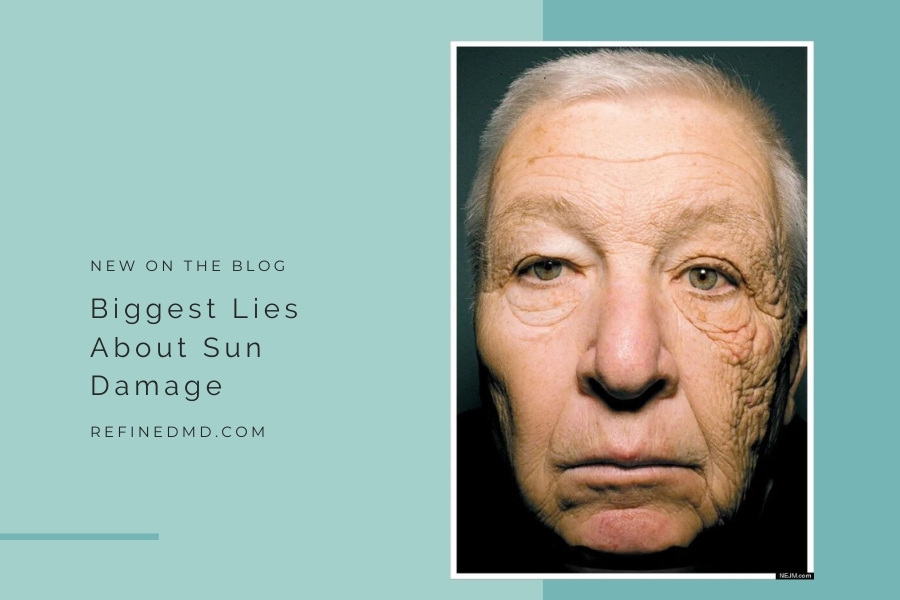
12 May Biggest Lies About Sun Damage
Sun damage: everyone gets it. Unless your parents were methodical about slathering every exposed inch of your skin with sunscreen from the moment you were born and you continued this vigilance uninterrupted your entire life, you have sun damage. At RefinedMD, we are committed to helping you remove and prevent sun damage for skin that is youthful, healthy, and clear. After all, lines and wrinkles aren’t the only signs of aging—brown spots are, too. And the worst part? All of these skin issues are exacerbated and sometimes caused by UV rays, not how many birthdays you’ve racked up.
However, when it comes to treating and preventing sun damage, there’s a lot of misinformation out there. Let’s take a look at some of the most common myths about sun damage and the truth behind them:
- A high SPF protects you totally from sun damage. This statement would be true if the “totally” was removed. Ultimately, sunscreen isn’t guaranteed to protect you from sun damage, but it does drastically minimize the risk of long-term damage.
- Sunscreen should be reapplied every 90 minutes. This used to be true. Now, experts agree that sunscreen should be reapplied every 75 minutes. That’s just an hour and fifteen minutes, so if you’ll be exposed to UV rays for some time, set an alarm.
- You don’t need to wear sunscreen when it’s winter/cloudy/rainy. Simply untrue. UV rays can and do penetrate clouds and rain. If the sun’s up, the sunscreen should be on.
- You don’t need to wear sunscreen indoors. This might be true, or it might not. A lot of people have a sweet home office setup next to big windows. If sun rays are touching your skin, you’re undergoing sun damage.
- You don’t need to wear sunscreen in a car/train/bus. Usually untrue. If you’re in a car, it’s almost guaranteed that you’re getting some sun damage. Search for pictures of long-haul truckers who have spent years on the road and see how much damage is on the left side of their face compared to their right. Luckily, medical-grade sunscreens come in travel size, so it’s easy to stash them in your car.
- The type of sunscreen doesn’t matter—it’s all about the SPF. Completely untrue. Sunscreens are comprised of various ingredients, and they vary in quality. Using medical-grade sunscreen is the best way to protect your skin. However, SPF also makes a difference. Still, experts agree that an SPF of at least 40 is good for most and there is little benefit to going higher than this rating.
- You’ll be fine if you tan and don’t burn. This is also false. While you’re somewhat lucky that you might not suffer through a sunburn, a tan is also an early sign of sun damage.
- You don’t need sunscreen if you’re a melanin queen/king. Not true. Even though sun damage and skin cancer occur more often in those with fairer skin, anyone of any skin tone and type can suffer from the effects of sun damage.
- Sun damage looks like (fill in the blank). Sun damage doesn’t look like a singular “thing.” It can be a sunburn, tan, brown spots, increase in freckles, darkening of current spots, early lines/wrinkles, early laxity, poor texture, or a melasma outbreak.
- I’m safe from skin cancer since I’ve been diligently using a good sunscreen since (fill in the year). Unfortunately, this is also untrue. Sun damage is cumulative so the damage you underwent as an infant, child, teen, etc. can all result in skin cancer later in life.
Finally, there’s one more whopper out there: you can’t really get rid of sun damage. Thankfully, this is so not true! There are many ways to undo sun damage including laser skin rejuvenation and chemical peels (to name just a few). At RefinedMD, we have all of the tools and treatments to help you erase years of damage and get back that youthful, clear skin. Schedule your consultation today by calling the office or completing the online form.
